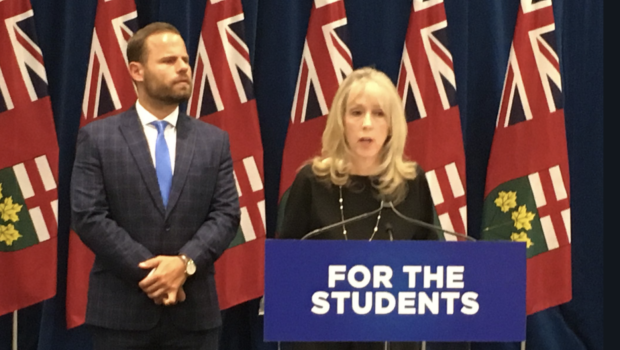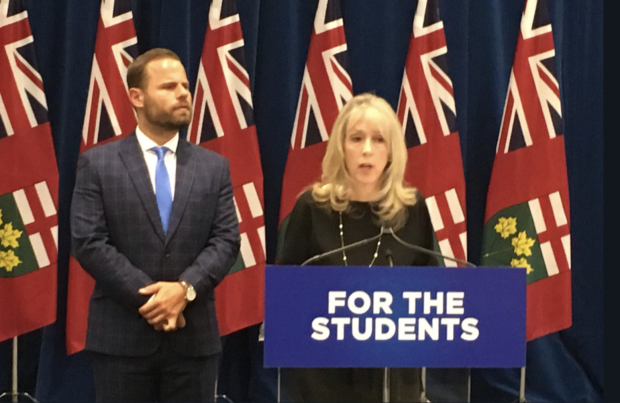

Student union chair concerned about tuition and OSAP changes
CanadaHumberPolitics Jan 17, 2019 Michael Ranger

Nour Alideeb, chairperson for the Canadian Federation of Students in Ontario (CFSON) says that “there are a number of concerns” regarding the changes to OSAP. “I wouldn’t call it a good day for students,” she says.
The Ontario government officially announced significant changes to tuition costs and the Ontario Student Assistance Program (OSAP) on Thursday.
The province will eliminate free tuition for low income students while decreasing tuition by 10 per cent for all colleges and universities across the province.
They will also be restoring OSAP to its 2016-17 levels and removing a 6-month grace period that gave students time after graduation before they had to start repaying their student loans.
Alideeb has doubts about whether the government is actually taking the best interests of students into consideration. She believes that any money saved on tuition could be offset by the changes to OSAP.
According to her the current model of OSAP allowed students to receive more grants. “One in four students were using the new program and were able to receive enough grants to cover their tuition,” she says. “By going back to the 2016-17 model these students will still be able to access OSAP but they will probably end up taking more student loans.”
With the removal of the 6-month grace period students will now be required to start repaying their student loans as soon as they graduate. “Often times students take that time to find a new job and get settled” into their life outside of school, says Alideeb.
Per a news release the government says that the changes to OSAP will “ensure it remains sustainable” and will direct a “greater proportion of OSAP funding to families with the greatest financial need.”
Making the announcement on Thursday, Merrilee Fullerton, the Minister of Training, Colleges and Universities says that “while we are lowering the cost of attending a post-secondary institution. We also have to look at the long-term sustainability of our funding programs.”
The government cited an Auditor General report released in December that highlighted some concerns in the way OSAP has been administered. The report showed that overspending did not proportionately result in higher enrolment.
“The Auditor General’s report in December left the door open for potential cuts to OSAP based on their analysis of the program,” says Alideeb.
That report “projected the program could balloon to over two billion dollars by 2020-21,” said Fullerton. “It is up to us to restore accountability, trust and sustainability to all of government, including OSAP.”
According to the province the decrease in tuition costs will save the average Arts or Science university undergraduate $660 annually and while saving the average college student $340 per year.
The government says that the decrease will “keep more money in the pocket of Ontario students and families.”
Alideeb said that she was a “little surprised” when the initial announcement of tuition cuts came out earlier this week. She says that the CFS has been “closely monitoring all of the decisions that the government has been making that will impact students. Whether it’s back to work legislation or the freedom of speech policy.”
The current tuition framework that caps tuition increases at three per cent expires at the end of this school year. The 10 per cent cut will come into effect for the 2019-20 academic year in place and remain in place for the 2020-21 year.
“I anticipate more details around the tuition fee framework which dictates how much tuition fees can increase year to year.” The government has only let on its framework for the next two academic years. “This policy is supposed to span around five years so I want to know the long-term plan,” said Alideeb.
Fullerton also announced a “Student Choice” initiative on Thursday, which according to the Minister, will allow students to select which ancillary fees they are willing to pay.
“For the first time ever, the government of Ontario is putting students first when it comes to their fees,” said Fullerton. She says ancillary fees often cost students up to $1,000 a year. “These fees often get allocated to services students do not use or to support organizations they do not support.”
“This is actually a tax on student unions,” says Alideeb. “Student unions are the organizations that collect ancillary fees. Unfortunately, what this means is we will see different types of cuts to services that student organizations provide.”
Alideeb believes that this new initiative is a way to give the government more power over students. “The student unions often hold the government accountable and push for changes when it comes to tuition fees,” she says.
Fullerton says that “students are adults, and we are treating them as such” by allowing them to see exactly where their fees are being allocated.
All fees for health and safety on university and college campuses will remain mandatory.
The “Student Choice” initiative will begin in September.
These follow on the already substantial changes that the Doug Ford government has made regarding post-secondary institutions. This past July Ford passed back-to-work legislation ending the York University strike. His government has also ended post-secondary construction projects and cancelled the committee to talk about faculties staffing and hiring’s wages.
The government also gave colleges and universities until Jan. 1 to implement new mandatory free-speech policies on their campuses.
